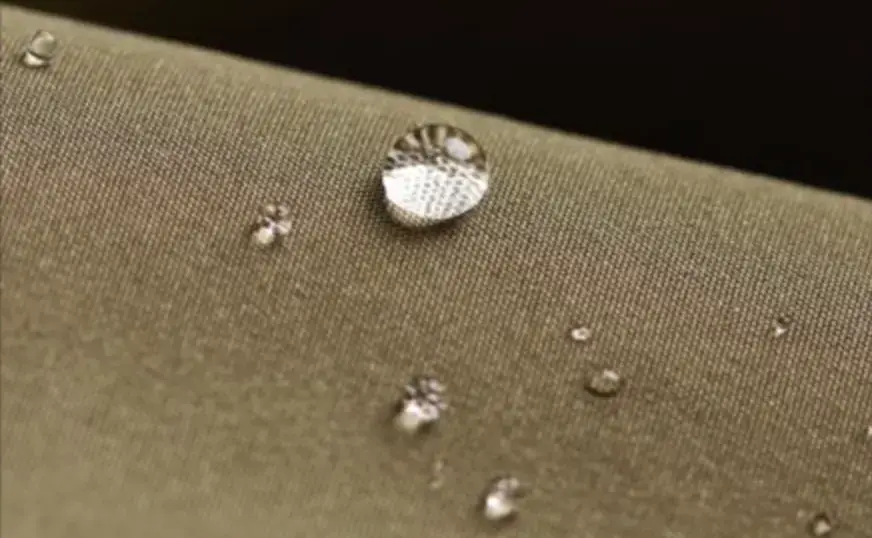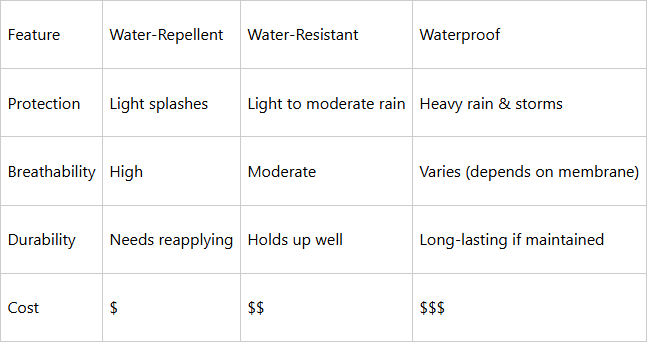

When shopping for outdoor gear or rain jackets, you’ve probably seen terms like waterproof, water-resistant, and water-repellent. But what do they really mean? And how do they work?
In this guide, we’ll break down the science behind these three levels of water protection, their key technologies, and how to choose the right one for your needs.
Water-repellent fabrics use a Durable Water Repellent (DWR) coating—typically a fluoropolymer or silicone-based treatment—to make water bead up and roll off the surface. This doesn’t make the fabric waterproof, it just prevents light moisture from soaking in immediately.
*Surface-level protection: Water forms droplets instead of soaking in.
*No water pressure resistance: Fails standardized waterproof tests (e.g., ISO 811).
*Wears off over time: DWR degrades with washing and abrasion but can be reapplied.
*Everyday jackets, hats, and backpacks.
*Light rain or splashes (e.g., coffee spills).
Water-resistant fabrics use tightly woven fibers (like nylon or polyester) combined with a lightweight coating (such as polyurethane) to slow down water penetration. Unlike waterproof fabrics, they allow some breathability but can’t withstand heavy rain for long.
*Moderate water resistance: Typically rated 1,000–5,000 mm H₂O (can handle light to moderate rain).
*Breathable: Allows sweat vapor to escape (~5,000–10,000 g/m²/24hr).
*Not fully sealed: Seams may leak under prolonged exposure.
*Hiking pants, windbreakers, and urban rain jackets.
*Short outdoor activities in drizzles or windy conditions.
True waterproof fabrics rely on multi-layer membranes (like Gore-Tex, eVent, or PU laminate) with microscopic pores. These pores are small enough to block liquid water but large enough to let sweat vapor escape—balancing waterproofness and breathability.
*High water resistance: Rated 10,000+ mm H₂O (can withstand storms).
*Fully sealed seams: Taped or welded to prevent leaks.
*Breathable membranes: Advanced fabrics like Gore-Tex offer 15,000–25,000 g/m²/24hr moisture evaporation.
*Mountaineering, heavy rain, snow sports, and survival gear.
*Situations where staying dry is critical (e.g., long expeditions).

✔ Daily use? Water-repellent or water-resistant is enough.
✔ Hiking in rain? Go for water-resistant (5,000mm+).
✔ Extreme weather? Only waterproof (10,000mm+) will do.
Understanding these three levels helps you pick the right gear without overpaying. Remember:
*Water-repellent = "Don’t worry about spills."
*Water-resistant = "I’ll survive a short rain."
*Waterproof = "Bring on the storm!"
Email cannot be empty
Password cannot be empty
Email format error
Email cannot be empty
Email already exists
6-20 characters(letters plus numbers only)
The password is inconsistent
Email format error
Email cannot be empty
Email does not exist
6-20 characters(letters plus numbers only)
The password is inconsistent